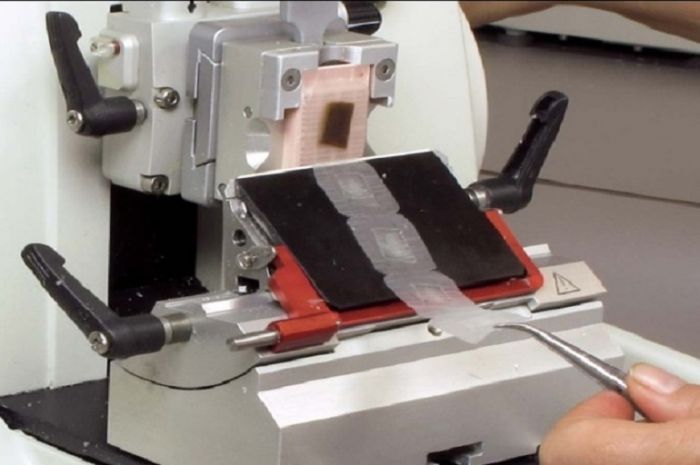
To prepare biological tissue for observation under a microscope, the tissue is usually cut in thin slices. Most biological tissue is too soft to cut; the knife would push into it and compress it, even if the cutting edge was very sharp. Therefore, the tissue is either frozen and sectioned in a cryostat or embedded in a hardening material like paraffin or resin, or cut while still soft with a vibrating blade microtome. The correct knife angle is the subject of much misunderstanding, misleading experience, and incorrect information passed between microtomists, but in fact can be logically derived.
The ideal knife for sectioning any material in any microtome, regardless of specimen hardness, would be an infinitely thin plane. This would be oriented parallel to the plane of the cutting movement. Unfortunately, infinitely thin planes are hard to come by, and in fact are found only in geometry books.
Real knives are a compromise, or several compromises, between physics, available materials, manufacturability, and cost. They must have measurable thickness to be held stable during cutting. So the leading edge must be made thinner than the main body of the knife, in a wedge shape, to enable both cutting and physical inflexibility. All microtome knives, whether resharpenable or disposable, have a wedge shaped part.
The entire knife could in theory be a smooth wedge, with gradual slope to the leading edge. However, sharpening the knife would then require removing a layer from at least one whole face of the knife. In practice, there is always a final bevel at a steeper angle for about a millimeter back from the cutting edge. The final bevel may be symmetrical on both sides, or not. The final bevel helps with sharpening and resharpening, only the bevel face(s) surface has to be removed to sharpen.
In a microtome, the center line through the cross-section of the knife, as shown in Fig 1a, is always positioned at an angle to the main direction of motion, not parallel to the direction of motion as it would be for an ideal infinitely thin knife. This is necessary because of the bevel. The angle is required because the knife is wedge shaped in cross section (at least the beveled leading edge of it). This compromise with the ideal knife has two negative consequences.
Suppose the knife is held so that the plane of motion (of the knife or specimen) is parallel to the centerline through the wedge, as would be appropriate with an ideal knife (Fig. 1 b). The face of the bevel on the specimen side of the knife would then be pressed hard against the specimen, increasingly so with more cutting movement, and apply compressive and forward pressure to the specimen. This is never good, and there are several possible consequences that depend on the tissue properties, knife properties, and on how well the specimen is adhered to the specimen holder:
Suppose instead that the knife is raised to a steep angle between a center line through the knife cross section and the axis of movement, so that the lower face of the wedge no longer pushes down and forward on the block (Figure 1c). However, the upper face of the wedge is always pushing on the uncut specimen above the cutting edge. This bends the section very sharply up at the line of cut as it is separated from the specimen block. As with any object with any thickness being bent, the lower surface of the section at the bend will be stretched and some separations will occur. The upper surface will be compressed. If the deformed specimen does not spring back, the tissue will roll into a tight roll. Even if it does spring back, and is prevented from rolling, the section will be altered. It is never good to bend the section any more that it has to bend given the need to push the wedge in. There are again several possible consequences, depending on the specimen and knife properties:
As a general principle, excessive bending of the section at the cut line is never advantageous in histology or material sectioning. However, errors of too shallow an angle are more damaging to the specimen than errors of too steep an angle. This leads inevitably to the conclusion that the correct knife angle should always be set in the following manner: Position the lower bevel face parallel to the specimen block and the plane of motion. Then raise the angle slightly (1/2 degree if you can manage such a thing) above the bevel angle to avoid having the lower bevel face slide over the specimen block and possibly produce friction damage. The correct knife angle positioning should be consistent regardless of the type of microtome, or any specimen property.
The consequences of incorrect knife angle will vary because of differences in specimen types, fixation and processing qualities and knife flexibility. Knife and disposable blade properties must also be considered because they can be manufactured with different profiles and angles. The correct knife angle is a property of the type of knife and the final bevel, and may be different on knives from different manufacturer’s and may change after re-sharpening. To reduce the likelihood of changes in knife angle with sharpening, the knife should always be professionally sharpened.